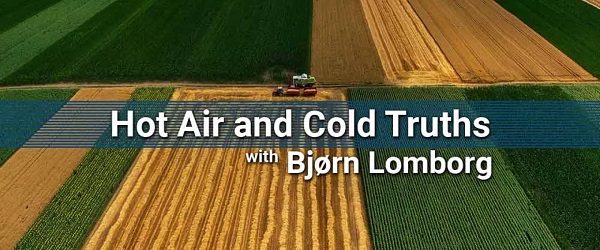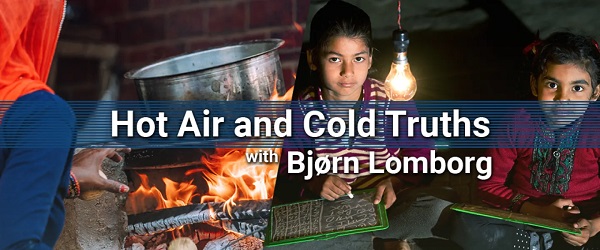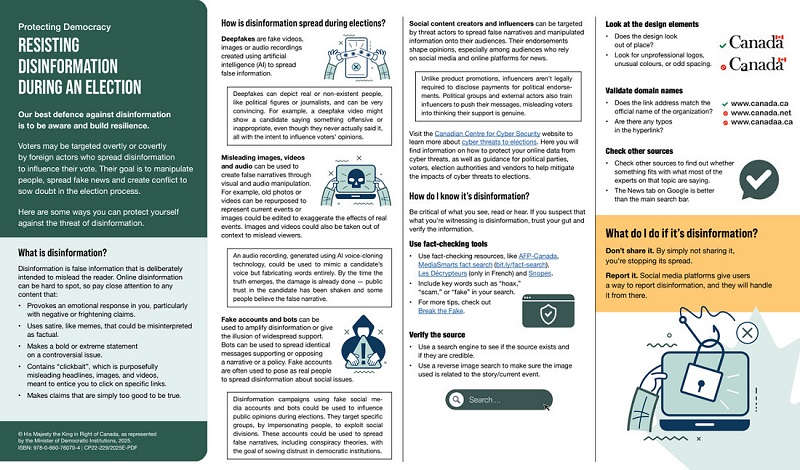Bjorn Lomborg
Climate change isn’t causing hunger

From the Fraser Institute
Surprisingly, a green, low-carbon world produces less and more expensive food, and makes over 50 million more people hungry by mid-century.
Food scarcity affects many people around the world. Canada can help, as the world’s fifth largest exporter of agricultural goods and the fourth largest exporter of wheat. Indeed, Canada exports so much food that measured in calories it can feed more than 180 million people.
We hear often that carbon cuts are a priority because climate change is causing world hunger and that even Canada will be hit by higher prices and less choice. These alarmist claims are far from true, and the recommended policies are counterproductive.
Over the past century, hunger has dramatically declined. In 1928, the League of Nations estimated that more than two-thirds of humanity lived in a constant state of hunger. By 1970, malnutrition afflicted just one-quarter of all people. Since 2008, the world has seen less than one-in-ten of all people go hungry, although Covid and Russia’s invasion of Ukraine have increased the percentage from a low of just over 7 per cent to 9 per cent in 2023.
This positive trend is because humanity has become much better at producing food, and incomes have risen dramatically. For instance, we have more than quintupled cereal production since 1926, and more than halved global food prices. At the same time, extreme poverty has dropped precipitously, allowing parents to afford to buy their children more and better food.
There is obviously still more to do, but securing food for the vast majority of the world has been an unmitigated success in the human development story.
As we move towards 2050, it is likely incomes will keep increasing, with extreme poverty almost disappearing. At the same time, food prices will likely slightly decline or stay about the same, as even more people switch to higher-quality and more expensive foods. All credible predictions foresee even lower levels of malnutrition by mid-century.
The impact of climate change on food supply is often portrayed as terrible, but in reality, it means that things will get much better slightly slower. It will change conditions for most farmers, making conditions better for some and worse for others. In total, it is likely the net outcome will be worse, but only slightly so. One peer-reviewed estimate shows the climate impact on agriculture is equivalent to reducing global GDP by the end of the century by less than 0.06 per cent.
CO₂ is a plant fertilizer, as is well-known by enterprising tomato producers, who routinely pump CO₂ into their greenhouses to boost productivity. We see a similar impact across the living world. Since the 1970s, the increasing CO₂ concentration has caused the planet to become greener, producing more biomass. Satellites show that since 2000, the world has gotten so many more green leaves that their total area is larger than the entire area of Australia.
In total, models show that without climate change, the global amount of food, measured in calories, produced in 2050 will likely increase 51 per cent from 2010. Even under extreme, unrealistic climate change, it will increase 49 per cent. Across all models and scenarios, the difference in calories per person is one-tenth of a percent.
The graph shows how many children died each year from malnutrition from 1990 to 2021, with the World Health Organization estimating the impact of climate change up to 2050. Since 1990, the average number of children dying has declined dramatically from 6.5 million to 2.5 million each year. This is an incredible success story.
The WHO expects the decline to continue, with annual deaths halving once again. But in a world with climate change, deaths will still decline but slightly more slowly. Unfortunately, the lower death decline in 2050 created almost all the media headlines from the WHO study, entirely ignoring the dramatic reduction in overall death.
The overarching response from climate campaigners is to demand radical emission cuts to help. But this ignores two important facts. First, trying to affect change through climate policy is the slowest, costliest and least impactful way to help. While even significant climate policy will take over half a century to have any measurable impact and cost hundreds of trillions, it will at best help increase available calories by less than one-tenth of a percentage point. Instead, a focus on increased economic growth is over one hundred times more effective, increasing calorie availability by over 10 per cent. Moreover, it would work in years instead of centuries, and deliver a host of other, obvious benefits.
Second, cutting emissions increases most agricultural costs, like pushing up prices for fertilizer and gas for tractors, along with increased competition for land for biofuels and reforestation. Uselessly, most models just ignore these costs — like the WHO simply imagining a world without climate change. But it turns out that the impact of cutting emissions harms food production much more than climate change does. Surprisingly, a green, low-carbon world produces less and more expensive food, and makes over 50 million more people hungry by mid-century.
While we are being told stories of climate agricultural catastrophes and urged to cut emissions dramatically, the evidence shows that the impact is tiny, making the world improve slightly less fast. The proposed cure is worse than the problem it seeks to fix.
Bjorn Lomborg
Global Warming Policies Hurt the Poor

From the Fraser Institute
Had prices been kept at the same level, an average family of four would be spending £1,882 on electricity. Instead, that family now pays £5,425 per year. The average UK person now consumes just over 10 kWh per day—a low point in consumption not seen since the 1960s.
We are often told by climate campaigners that climate change is especially pernicious because its effects over coming decades will disproportionately affect the poorest people in Canada and the world. Unfortunately, they miss that climate policies are directly hurting the poor right now.
More energy leads to better, healthier, longer lives. Less energy means fewer opportunities. Climate policies demand we pay more for less reliable energy. The impact is greater if you’re poorer: the wealthy might grumble about higher costs but can generally absorb them; the poor are forced to cut back.
For evidence, look to the United Kingdom which has led the world on stiff climate policies and net zero promises for some two decades, sustained by successive governments: its inflation-adjusted electricity price, weighted across households and industry, has tripled from 2003 to 2023, mostly because of climate policies. The total, annual UK electricity bill is now $CAD160 billion, which is $CAD105 billion more than if prices in real terms had stayed unchanged since 2003. This unnecessary increase is so costly that it is twice the entire cost that the UK spends on elementary education. Had prices been kept at the same level, an average family of four would be spending £1,882 on electricity. Instead, that family now pays £5,425 per year.
Over that time, the richest one per cent absorbed the costs and even managed to increase their consumption. But the poorest fifth of UK households saw their electricity consumption decline by a massive one-third.
The effects of climate policies mean the UK can afford less power. The average UK person now consumes just over 10 kWh per day—a low point in consumption not seen since the 1960s. While global individual electricity consumption is steadily increasing, the energy available to an average Brit is sharply decreasing.
Climate policies hurt the poor even in energy-abundant countries like Canada and the United States. Universally, poor people in well-off countries use much more of their limited budgets paying for electricity and heating. US low-income consumers spend three-times more on electricity as a percentage of their total spending than high-income consumers. It’s easy to understand why the elites have no problem supporting electricity or gas price hikes—they can easily afford them.
As mentioned in the article on cold and heat deaths, high energy prices literally kill people—and this is especially true for the poor. Cold homes are one of the leading causes of deaths in winter through strokes, heart attacks, and respiratory diseases. Researchers looked at the natural experiment that happened in the United States around 2010, when fracking delivered a dramatic reduction in costs of natural gas. The massive increase in availability of natural gas drove down the price of heating. The scientists concluded that every single winter, lower energy prices from fracking save about 12,500 Americans from dying. To put this another way, all else being equal, a reversal and hike in energy prices would kill an additional 12,500 people each year.
As bleak as things are for the poor in rich countries, virtue-signaling climate policy has even farther-reaching impacts on the developing world, where people desperately need more access to the cheap and plentiful energy that previously allowed rich nations to develop. In the poor half of the world, more than two billion people have to cook and keep warm with polluting fuels such as dung and wood. This means their indoor air is so polluted it is equivalent to smoking two packs of cigarettes a day—causing millions of deaths each year.
In Africa, electricity is so scarce that the total electricity available per person is much less than what a single refrigerator in the rich world uses. This hampers industrialization, growth, and opportunity. Case in point: The rich world on average has 650 tractors per 50km2, while the impoverished parts of Africa have just one.
But rich countries like Canada—through restrictions on bilateral aid and contributions to global bodies like the World Bank—refuse to fund anything remotely fossil fuel-related. More and more development and aid money is being diverted to climate change, away from the world’s more pressing challenges.
Canada still gets more than three-quarters of its energy (not just electricity) from fossil fuels. Yet, it blocks poor countries from achieving more energy access, with the naïve suggestion that the poor “skip” to intermittent solar and wind with an unreliability that the rich world does not accept to fulfil its own, much bigger needs.
A large 2021 survey of leaders in low- and middle-income countries shows education, employment, peace and health are at the top of their development priorities, with climate coming 12th out of 16 issues. But wealthy countries refuse to pay attention to what poor countries need, in the name of climate change.
The blinkered pursuit of climate goals blinds politicians in rich countries like Canada to the impacts on the poor, both here and across the world in developing nations. Climate policies that cause higher energy costs and push people toward unreliable energy sources disproportionately burden those least able to bear them.
Bjorn Lomborg
The stupidity of Net Zero | Bjorn Lomborg on how climate alarmism leads to economic crisis

From spiked on YouTube
Note: This interview is focused on Europe and the UK. It very much applies to Canada. The 2025 Federal Election which will see Canadians choose between a more common sense approach, and spending the next 4 years continuing down the path of pursuing “The Stupidity of Net Zero”.
European industry is in freefall, and Net Zero is to blame.
Here, climate economist Bjorn Lomborg – author of Best Things First and False Alarm – explains how panic over climate change is doing far more damage than climate change itself. Swapping cheap and dependable fossil fuels for unreliable and expensive renewables costs our economies trillions, but for little environmental gain, Lomborg says.
Plus, he tackles the myth of the ‘climate apocalypse’ and explains why there are more polar bears than ever.
Support spiked: https://www.spiked-online.com/support/
Sign up to spiked’s newsletters: https://www.spiked-online.com/newslet…
-

 2025 Federal Election1 day ago
2025 Federal Election1 day agoRCMP Whistleblowers Accuse Members of Mark Carney’s Inner Circle of Security Breaches and Surveillance
-

 2025 Federal Election2 days ago
2025 Federal Election2 days agoMEI-Ipsos poll: 56 per cent of Canadians support increasing access to non-governmental healthcare providers
-

 2025 Federal Election2 days ago
2025 Federal Election2 days agoAI-Driven Election Interference from China, Russia, and Iran Expected, Canadian Security Officials Warn
-

 Health2 days ago
Health2 days agoTrump admin directs NIH to study ‘regret and detransition’ after chemical, surgical gender transitioning
-

 Business7 hours ago
Business7 hours agoChina, Mexico, Canada Flagged in $1.4 Billion Fentanyl Trade by U.S. Financial Watchdog
-

 2025 Federal Election1 day ago
2025 Federal Election1 day agoBureau Exclusive: Chinese Election Interference Network Tied to Senate Breach Investigation
-

 2025 Federal Election16 hours ago
2025 Federal Election16 hours agoTucker Carlson Interviews Maxime Bernier: Trump’s Tariffs, Mass Immigration, and the Oncoming Canadian Revolution
-

 Daily Caller5 hours ago
Daily Caller5 hours agoTrump Executive Orders ensure ‘Beautiful Clean’ Affordable Coal will continue to bolster US energy grid








